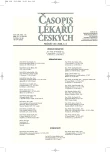Development of Incidence of Post-dural Puncture Headache in Patients Undergoing Caesarean Section in Spinal Anaesthesia at the Department of Obstetrics and Gynecology in Olomouc during 2003–2004
Authors:
M. Lubušký; E. Berta 1; M. Procházka; O. Marek 1; Milan Kudela
Authors‘ workplace:
Gynekologicko–porodnická klinika LF UP a FN, Olomouc
; Klinika anestezie a resuscitace LF UP a FN, Olomouc
1
Published in:
Čas. Lék. čes. 2006; 145: 204-208
Category:
Original Article
Overview
Background.
Paper gives the analyse of the incidence of post-dural puncture headache in patients undergoing caesarean section in spinal anaesthesia at the Department of Obstetrics and Gynecology in Olomouc in 2003–2004.
Methods and Results.
Post-dural puncture headache following caesarean section in spinal anaesthesia in 2003 was retrospectively analysed. Subsequently, measures to reduce the incidence of this complication (use of Whitacre and Atra ucan needles) were implemented. 2004 patients were followed prospectively. 54 caesarean sections – 16.3 % (54/331) were performed in spinal anaesthesia in 2003. Following needles were used to establish spinal blockade: Quincke 22G – 35.2 % (19/54), Quincke 25G – 50 % (27/54), Atraucan 26G – 14.8 % (8/54). Post-dural puncture headache occurred in 9 cases – 16.6 % (9/54) (22G – 7x, 25G – 2x), the onset of symptoms occurred after 24 to 65 hours after the spinal blockade (mean 41.7). It was necessary to perform epidural blood patch (EBP) in 7 cases – 77 % (7/9) – 12.9 % (7/54) (22G – 5x, 25G – 2x). Epidural blood patch (EBP) was performed after 7 to 45 hours after the onset of symptoms (median 28.4). The age of patients at the time of delivery ranged between 22 to 43 years (median 34.5). 36 caesarean sections – 8.4 % (36/426) were performed in spinal anaesthesia in 2004. Following needles were used to establish spinal blockade: Whitacre 27G – 63,9 % (23/36), Atraucan 26G – 13,9 % (5/3), Quincke 25G – 11,1 % (4/36), Quincke 22G – 11,1 % (4/36). Post-dural puncture headache (PDPH) occurred in 3 cases – 8.3 % (3/36) (25G – 1x, 22G – 2x), the onset of symptoms occurred after 24 to 54 hours after spinal blockade (median 36.0). It was not necessary to perform epidural blood patch. The age of patients at the time of delivery ranged between 22 to 39 years (median 28.5).
Conclusions.
Incidence of post-dural puncture headache (PDPH) is significantly higher in pregnant women and in puerperal period compared to general population. The use of appropriate needles for spinal blockade and adequate level of anaesthesiologist’s skills lead to lower incidence of post-dural puncture headache (PDPH) after caesarean section performed in spinal anaesthesia.
Key words:
post-dural puncture headache, PDPH, epidural blood patch, spinal blockade, caesarean section.
Labels
Addictology Allergology and clinical immunology Angiology Audiology Clinical biochemistry Dermatology & STDs Paediatric gastroenterology Paediatric surgery Paediatric cardiology Paediatric neurology Paediatric ENT Paediatric psychiatry Paediatric rheumatology Diabetology Pharmacy Vascular surgery Pain management Dental HygienistArticle was published in
Journal of Czech Physicians

Most read in this issue
- Paranoid Syndrome, Paranoid Reaction, Paranoia
- Chronic Post-mastectomy Pain
- Percutaneous Sacroplasty in Sacral Insufficiency Fracture Treatment
- Development of Incidence of Post-dural Puncture Headache in Patients Undergoing Caesarean Section in Spinal Anaesthesia at the Department of Obstetrics and Gynecology in Olomouc during 2003–2004
